Albert Park and Lake
Albert Park and Albert Park Lake are situated in the City of Port Phillip, Victoria, Australia, 3 km south of the Melbourne CBD.
| Albert Park | |
|---|---|
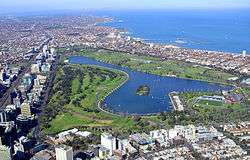 Aerial view of Albert Park and Lake | |
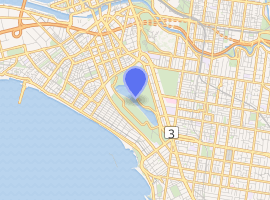
| |
| Type | Public Park, Lake, Motor Racing Venue |
| Location | Melbourne, Australia |
| Coordinates | 37.848°S 144.971°E |
| Area | 225 ha (560 acres) |
| Opened | 1864 |
| Operated by | Parks Victoria |
| Status | Open |
| Paths | Sealed shared pedestrian / bicycle paths |
| Terrain | Flat plains; Large lake |
| Water | Albert Park Lake |
| Vegetation | European themed, Australian native, grasslands |
| Connecting transport | Tram, Bus, Car |
| Landmarks | Albert Park Lake, Melbourne Grand Prix Circuit |
| Facilities | Toilets, barbecues, playground, cafe/restaurant |
| Albert Park Lake | |
|---|---|
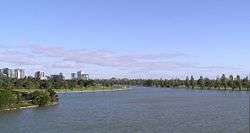 Albert Park Lake looking south-east from the lookout tower at The Point restaurant. | |
| Location | Albert Park, Victoria |
| Coordinates | 37°50′47″S 144°58′12″E[1] |
| Type | Freshwater |
| Basin countries | Australia |
| Surface area | 0.49 km2 (49 ha; 120 acres) |
The park encompasses 2.25 square kilometres (225 ha; 560 acres) of parkland including Albert Park Lake (0.49 square kilometres (49 ha; 120 acres)[2]) and provides numerous ovals, sporting facilities, the Albert Park Public Golf Course, a 4.7-kilometre (2.9 mi) walking track around the lake, and the Melbourne Grand Prix Circuit. It is bordered by Albert Road, Queens Road, Fitzroy Street and Canterbury Road. Surrounding suburbs include Albert Park, Middle Park, St Kilda, Melbourne and South Melbourne.
History
Early history
Albert Park was originally part of the extensive Yarra River Delta, which involved vast areas of wetlands and sparse vegetation, interspersed by lagoons, some of which were quite large, including the lagoon from which Albert Park Lake was created. The area was occupied by localised tribes of Indigenous Australians, the Wurundjeri people, for around 40,000+ years prior to European settlement, and was one of many sites around Melbourne where regular corroborees (meetings) were held.
19th and 20th centuries
Following British settlement from 1835 onwards, much of the Yarra River delta was drained to dry the land and enable agriculture, housing and grazing. Through the 1840s and 1850s, the area now occupied by Albert Park itself was unofficial parkland, used for military training, grazing and hunting. In 1864 the area was officially proclaimed a public park and named Albert Park in honour of Queen Victoria's devoted consort, Prince Albert.
By 1875, areas of the park along Queens Road and in St. Kilda, had been sold off for housing and other uses, reducing the park from 385 to 231 hectares. Through much of the late 19th Century, allotments were allocated for sporting facilities such as Football, Tennis, Bowling, Cricket and Boating. Between 1873 and 1880, silt in the lagoons was excavated and used as infill around the lagoon itself to create a permanent lake. In 1890, water was diverted from the Yarra River to help fill the lake. Through the late 19th and early 20th Centuries, the park was used as a tip, a camp for the armed services, scenic drives, picnics and many other forms of recreation.
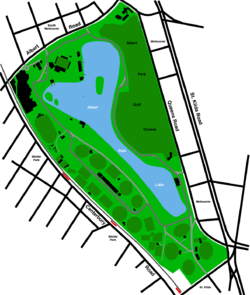
In 1882, 1918 and 1935, adjoining educational institutions acquired land from the park, to much opposition at the time. From 1941–1950, the Army occupied large areas of land in the park, this land was given back to the park during the 1950s and 1960s. From 1953–1958, motor racing was held within the park, including the 1953 and 1956 Australian Grands Prix was held within the park, around the lake, until it was moved to the circuit on Phillip Island. Through much of the 1960s, 1970s and 1980s, general park maintenance was neglected as funding became hard to come by, finances were collected from a carousel and similar facilities.
Recent years
During the early 1990s, the lake was drained to remove weed infestations, rubbish and other debris that had accumulated over the years. In 1993, it was announced that the Australian Grand Prix would be moved from the Adelaide Street Circuit to a reconstructed Albert Park Circuit, loosely following the 1950s configuration. This was met with much opposition, but the project went ahead and a host of sporting facilities were subsequently constructed and funding allocated to improve the parklands followed.
Albert Park is enjoyed by approximately five million visitors annually. Vestiges of Albert Park's Aboriginal history still remain, the most noticeable being the large ancient River Red Gum Tree, reputed to be the site of many corroborees. It is thought to be over 300 years old, the oldest remnant tree in the Port Phillip area, located next to Junction Oval on the corner of Fitzroy Street and Queens Road, St Kilda.
The Clarendon Street gates were originally built of wooden pickets in 1910, they were cast in wrought iron in 1939 and can still be seen today.
Habitat and fauna
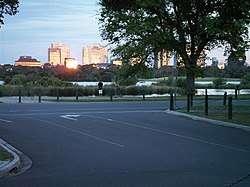
The parkland, Albert Park lake, and Gunn Island, provides a grassy wetlands habitat for nearly two hundred bird species, both resident and transient. A 1990 study recorded 31 bird species as breeding in the park with a total of 21 these indigenous species. Migratory species include the flame robin, white-throated needletail and sacred kingfisher.
Locally rare native bird species that have been recorded in the park include little egret, laughing kookaburra, Australian shelduck, Cape Barren goose, great-crested grebe, white-bellied sea eagle and whiskered tern, while little ravens, Australian magpies, long-billed corella, sulphur-crested cockatoo, willie wagtails and magpie-larks are common. Common lake birds include black swans and Pacific black ducks, Australasian grebe, Eurasian coots, purple swamphen, dusky moorhen and all four freshwater cormorant species. Feral white swans were removed from the park between the 1980s and 1990s. Feral common mynas and common starling are also numerous in the park.
Native mammals include common brushtail possums, common ringtail possums and water rat. Common bent-wing bats, white-striped mastiff bats and Gould's wattled bat have also been recorded in the park. Feral black rats are also common in the park. Foxes have also been spotted on occasion at night.
Several reptiles and amphibians, such as the marbled gecko make their home in the park.
The lake is home to some freshwater fish species.[3] The department of Primary Industries releases native golden perch for recreational fishing purposes. European carp, a noxious pest are the most commonly found fish in the lake and is subject to control programs.
A vegetation survey in 1992 found 117 species of plants, a mixture of native and exotic species.
A native revegetation area in the south east corner of the park features a large ancient river red gum tree known as the Corroboree Tree, a heritage registered eucalypt of cultural significance as a pre-European gathering place.
Facilities and features
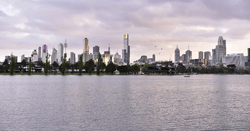
There are nine separate picnic areas, most with barbecues, shelters and toilets. There is a vast network of sealed and unsealed, shared pedestrian/bicycle paths, centred on a main route that circles the lake. There are several playgrounds of varying sizes, the park also hosts many large sporting facilities, including:
- Melbourne Sports and Aquatic Centre - International class swimming and sports facilities.
- Lakeside Stadium - Home ground of Athletics Australia, Athletics Victoria and South Melbourne FC.
- Albert Park Public Golf Course - including a golf driving range on the opposite side of the lake.
- Junction Oval - historic sporting ground.
- Several boating and sailing clubs - located on the north and eastern sides of the lake.
- Several rowing clubs at either ends of the lake, specifically [2014] APSMRC [Albert Park South Melbourne], Caulfield Grammar School, Argonauts, YWCA, Korowa GS, Wesley College, Brighton Grammar School.
- Restaurants and Function Centres - including the Powerhouse, the Point and Carousel.
- Various sporting grounds/ovals - including Harry Trott Oval, Holdsworth Pavilion, Ross Gregory Oval, Stuart King Pavilion, Ian Johnson Oval, and several smaller bowls clubs, tennis clubs, cricket ovals, soccer and rugby fields located in the south western side of the park.
Other features
- Gunn Island - an artificial island. A second island at the southern end was removed by the military as a training exercise in the early 1950s.
- The Aquatower - a large water spout/fountain, which is currently turned off due to water restrictions.
Events
The Australian Grand Prix is held around the Melbourne Grand Prix Circuit around the lake in March each year; usually on the Labour Day weekend. Every May the RSPCA holds the Million Paws Walk to raise needed income for their work with animals.
The Albert Sailing Club holds regular regattas on Saturdays. The Albert Park Yacht club, established in 1871 and the oldest continuing yacht club in Victoria, runs sailing classes over winter months on Albert Park lake and also has competitive sailing on Saturdays.
Albert Park is home to a 5 km Parkrun event. Albert Melbourne Parkrun starts at 8am every Saturday from the Coot Picnic area.
Gallery
 Albert Park Lake, looking due east past The Point to Gunn Island
Albert Park Lake, looking due east past The Point to Gunn Island.jpg) Albert Park - The Point Restaurant
Albert Park - The Point Restaurant Albert Park - Carousel Events Venue Entrance
Albert Park - Carousel Events Venue Entrance Albert Park - Carousel Outdoor Open Space
Albert Park - Carousel Outdoor Open Space Albert Park Lake and surrounds as viewed southward from the Eureka Tower observation deck
Albert Park Lake and surrounds as viewed southward from the Eureka Tower observation deck
References
- "Albert Park Lake". Vicnames. Government of Victoria. 2 May 1966. Archived from the original on 4 June 2014. Retrieved 4 June 2014.
- "Archived copy" (PDF). Archived from the original (PDF) on 8 June 2011. Retrieved 18 May 2009.CS1 maint: archived copy as title (link)
- "History of recreational fishing and stocking at Melbourne's Albert Park Lake". Retrieved 2 October 2015.